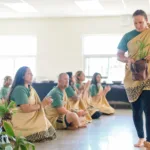Ten Kaʻū community residents recently completed “Ka‘ū Hoa Pili ‘Āina,” a four-month, ‘āina-based education training program which is part of the Hawai‘i Tourism Authority’s (HTA) destination management efforts and Hawai‘i Island Community-Based Action Stewardship Program.
Facilitated by the non-profit Ka ‘Ohana o Honu‘apo, the “Ka‘ū Hoa Pili ‘Āina” program focused on recruiting and training local stewards in the practices of mālama ‘āina built on the foundation of cultural practices and protocols, conservation and biological sciences, and place-based messaging about the Ka‘ū area.
As part of the training, Ka ‘Ohana o Honu‘apo worked with 13 other organizations to share information on a wealth of topics, including the Hawai‘i Wildlife Fund, Nā Mamo O Kāwā, Kua‘āina Ulu Auamo (KUA)’s Limu Hui, The Nature Conservancy, Hawai‘i Volcanoes National Park, Kalanihale, Hui Aloha Kīholo, Edith Kanaka‘ole Foundation, Kamehameha Schools, Volcano Rare Plant Facility, Kaulana Mahina, Island CPR and Mālama Pono Punalu‘u.
Trainees delved into land-use changes, watershed protection, heritage management and coastal restoration projects. They completed CPR and First Aid training and learned communication skills for sharing the importance of pono practices with visitors and kama‘āina.
In addition to learning species identification and monitoring practices, the trainees took their skills out in the field to conduct ʻopihi monitoring and limu surveys. Other immersive activities included forest and loko i‘a (Hawaiian fish pond) restoration, marine debris removal, community-based management, communication skills building, mo‘olelo sharing and learning about impacts to watersheds.
The trainees also studied the impacts of Rapid ʻŌhiʻa Death on Hawai‘i’s forests and ways to mitigate its spread through decontamination strategies and protocols.
Trainees received a monthly stipend for their participation and were required to attend all instructional events and steward-related opportunities, as well as engage with visitors to effectively communicate pono behaviors and safety protocols. In addition, they participated in a number of volunteer opportunities with multiple groups and organizations in Ka‘ū and South Kona. Trainees hailed from across the Kaʻū District.
With a deeper connection to their ‘āina, the newly launched group of stewards can seek to reconnect with the different organizations and individuals they worked with during the training to remain involved in efforts to help mālama ‘āina. This can be done on a volunteer basis or through employment opportunities.
Funded and supported by HTA and administered by IHVB, the Hawai‘i Island Community-Based Action Stewardship Program builds on the success of other community-based programs around the state including at Hanauma Bay State Park, Hā‘ena State Park and Lē‘ahi (Diamond Head State Monument).
For more information regarding destination management and stewardship, visit https://holomua.hawaiitourismauthority.org/hawaii-island/.
Photo credit: Hawaiʻi Tourism Authority
